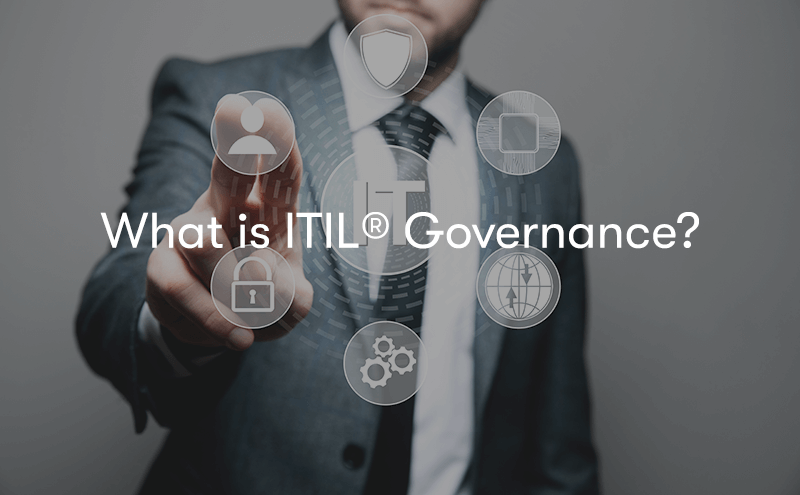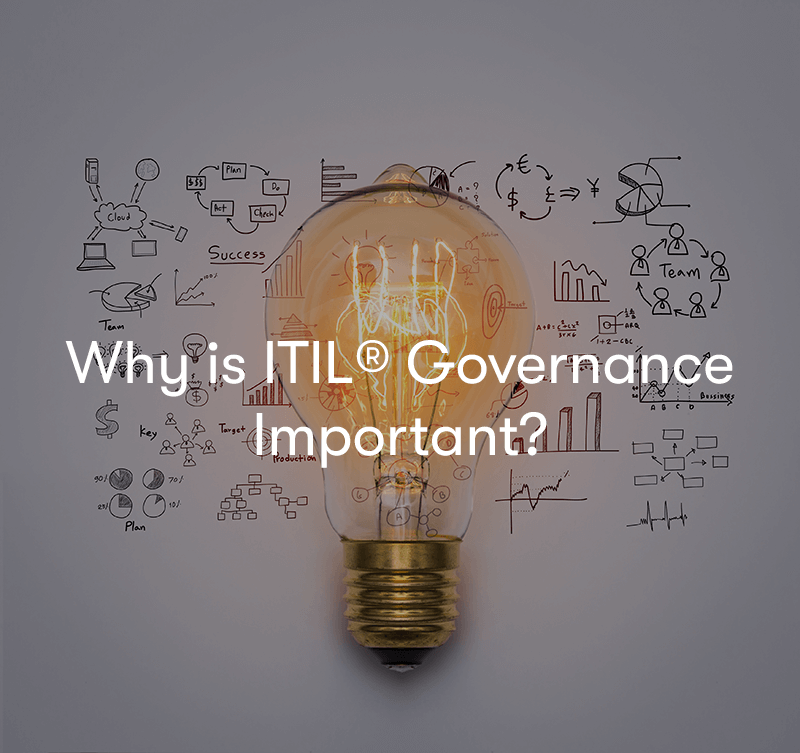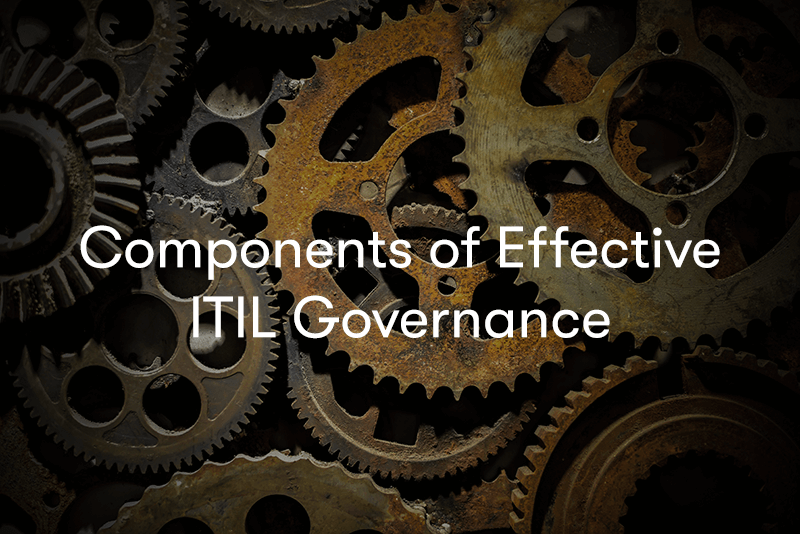IT governance refers to the framework and processes that organisations implement to ensure effective and efficient management of their information technology IT resources.
The primary goal of IT governance is to align IT activities with the overall organisational goals and objectives, enabling organisations to make informed decisions about IT investments, resource allocation, and risk management. It helps organisations maximise the value of their IT investments while minimising potential risks.
- An Introduction to ITIL® Governance
- What is IT Governance?
- What is ITIL® Governance?
- Why is ITIL® Governance Important?
- Applying Governance to Your Company
- How Can We Help?
- IT Governance Frameworks
- Components of Effective ITIL Governance
- What Are the Benefits of ITIL Governance?
- Final Notes On ITIL Governance
An Introduction to ITIL® Governance
Governance has always been a part of the ITIL framework, but it was introduced as a more formalised concept in the ITIL v3 (2007) release. In ITIL v3, governance was included as a key component of the service management framework and was defined as "the framework of accountability and authority required to achieve the enterprise's goals and objectives, and to manage risk appropriately."
The inclusion of governance in ITIL v3 reflected the growing recognition that effective IT service management requires more than just the implementation of processes and procedures; it also requires a structured approach to managing accountability and decision-making across the organisation.
Since then, governance has remained a key component of the ITIL framework, and it is included in the latest version of ITIL, ITIL 4 (2018). In ITIL 4, governance is defined as "the exercise of authority and control over how assets and resources are utilised to achieve enterprise objectives."
Effective governance is critical to the success of IT service management, as it helps to ensure that IT services are aligned with business goals, that risks are managed appropriately, and that resources are used efficiently and effectively.
Governance is an essential component of IT service management as it provides a framework for accountability, decision-making, and risk management across the organisation. Effective governance ensures that IT services are aligned with organisational goals, that risks are identified and managed appropriately, and that resources are used efficiently and effectively.
(Start your ITIL Journey with our intensive ITIL V4 Foundation course today)
What is IT Governance?

As we have already indicated Governance is the framework of authority, accountability, and decision-making required to achieve an organisation's objectives and manage risks appropriately. Governance provides a structured approach to managing and controlling an organisation, ensuring that resources are used efficiently and effectively, and that risks are identified and managed appropriately. In the context of IT service management, governance helps to ensure that IT services are aligned with the organisation’s goals, that risks related to IT services are identified and managed appropriately, and that resources are used efficiently and effectively to deliver high-quality IT services.
The concept of governance can be traced back to ancient civilisations such as Greece and Rome, where governing bodies were responsible for making decisions and managing the affairs of the state.
In the modern era, governance has become increasingly important as organisations have become more complex and global in nature. The development of corporate governance practices, for example, can be traced back to the early 20th century, when companies began to adopt formal structures to manage their affairs.
In the context of IT service management, governance has been a part of the ITIL framework since its inception in the 1980s. However, the concept of governance has evolved over time as the ITIL framework has been updated to reflect changing needs and technological advancements.
Definition of Governance
The act or process of governing or overseeing the control and direction of something.
What is ITIL® Governance?

Governance in ITIL refers to the set of processes, policies, and procedures that are put in place to ensure that IT services are managed effectively and efficiently.
ITIL governance includes a number of key elements, such as:
Policy
Establishing policies that define how IT services will be managed and what levels of service are expected.
Process
Implementing processes that support the policies and help to ensure that services are delivered in a consistent and reliable manner.
Procedures
Developing procedures that outline the steps required to perform specific tasks or activities within the IT service management process.
Roles and Responsibilities
Defining the roles and responsibilities of individuals and teams involved in the IT service management process.
Metrics
Establishing metrics to measure the effectiveness and efficiency of IT service management, and to monitor performance against agreed service levels.
Reporting
Developing reports that provide visibility into IT service management performance and help to identify areas for improvement.
Effective ITIL governance is critical to the success of IT service management. It helps to ensure that IT services are aligned with business goals, that they are delivered consistently and reliably, and that they meet the needs of stakeholders. By implementing ITIL governance practices, organisations can improve the quality of their IT services, reduce costs, and enhance customer satisfaction.
Why is ITIL® Governance Important?

Governance is an essential component of IT service management as it provides a framework for accountability, decision-making, and risk management across the organisation. Here are some specific reasons why governance is so important in IT service management:
Alignment with Organisational Goals
Effective governance ensures that IT services are aligned with the organisation's overall business goals and objectives. This alignment helps to ensure that IT services are focused on delivering value to the business, rather than simply meeting technical requirements.
Risk Management
Governance helps to identify and manage risks related to IT services. By implementing effective governance practices, organisations can ensure that risks are identified, assessed, and managed appropriately, reducing the likelihood of service disruptions or other adverse events.
Resource Management
Governance helps to ensure that resources are used efficiently and effectively. By implementing effective governance practices, organisations can optimise the use of IT resources, reducing waste and improving service delivery.
Decision-making
Governance provides a framework for decision-making related to IT services. By implementing effective governance practices, organisations can ensure that decisions are made in a structured and transparent manner, improving the overall quality of decision-making.
Compliance
Governance helps organisations to comply with regulatory requirements and industry standards related to IT service management. By implementing effective governance practices, organisations can ensure that they meet their obligations under applicable regulations and standards.
In summary, effective governance is critical to the success of IT service management. By providing a framework for accountability, decision-making, and risk management, governance helps to align IT services with organisational goals, manage risks effectively, optimise resource use, and comply with regulatory requirements and industry standards.
Applying Governance to Your Company
Applying governance to an organisation involves establishing a framework of authority, accountability, and decision-making that helps to achieve the organisation's objectives and manage risks appropriately. Here are some steps that your organisation can take to apply effective governance:
Define Governance Objectives
The first step in applying governance to your organisation is to define the objectives of governance. These objectives should align with your organisation's overall goals and objectives and should focus on areas such as risk management, resource optimisation, decision-making, and compliance.
Establish Governance Structure
Once the governance objectives have been defined, the next step is to establish a governance structure that enables effective decision-making and risk management. This structure should include roles and responsibilities, decision-making processes, and mechanisms for oversight and accountability. Establishing a Governance, Risk and Compliance (GRC) function may be an appropriate approach.
Develop Policies and Procedures
Governance policies and procedures should be developed to guide decision-making and risk management processes. These policies and procedures should be aligned with the governance objectives and should be reviewed and updated regularly to ensure that they remain relevant and effective.
Implement Governance Processes
Governance processes should be implemented to ensure that the policies and procedures are followed consistently. This may involve establishing committees, reviewing and approving key decisions, monitoring compliance with policies and procedures, and conducting regular risk assessments.
Monitor and Evaluate Governance
The final step in applying governance is to monitor and evaluate the effectiveness of the governance framework. This involves measuring the outcomes of governance processes, identifying areas for improvement, and making changes to the governance framework as necessary.
Continually improve governance
Continual improvement in governance involves regular monitoring and evaluation of governance processes, policies, and procedures to identify areas for improvement. This may involve analysing data, gathering feedback from stakeholders, conducting audits or assessments, and reviewing best practices and industry standards.
Once areas for improvement have been identified, your organisation can develop and implement improvement initiatives to address these areas. Improvement initiatives may include changes to policies and procedures, training and development programs, process improvements, or technology upgrades.
How Can We Help?

Today, organisations are dependant on IT to satisfy their corporate aims, meet their business needs and deliver value to their customers. For this to be achievable in a manageable, accountable, and repeatable process, organisations must adopt best practices.
Strong and effective direction with ITIL® 4 Strategist: Direct, Plan & Improve (DPI)
For many organisations making this happen is easier said than done, with many barriers to both continual improvement and strategic thinking. However, this can be simplified through the use of governance. Though some may see governance as a management tool for monitoring and making people do the right things, establishing healthy governance can instead be an operational enabler to help direction, plans and empower strategic capabilities.
Our ITIL® 4 Strategist: Direct, Plan & Improve course will provide ITIL® Practitioners with a practical and strategic method for planning and delivering continual improvement with the necessary agility. The ITIL® 4 Foundation certificate is the prerequisite for our ITIL® 4 Strategist Direct, Plan & Improve (DPI) training course.
For more information on the courses and how they can be relevant to you, please do not hesitate to contact us.
IT Governance Frameworks
There are many ITSM (IT Service Management) frameworks to help organisations effectively manage ITSM. Many of these frameworks and methodologies to different approaches to governance:
ITIL® 4
Management is the nexus between governance and operations. ITIL® describes how to use the service portfolio as a tool of governance to drive an organisation. ITIL® emphasises the guiding principles & continual improvement have to be applied across the lifecycle of the services and to all components of the service value system, including governance.
COBIT
COBIT (Control Objectives for Information and related Technology) is aligned closely with ITIL® and provides advice on IT and how to ensure it is contributing to organisational goals. COBIT offers a number of perspectives into the control objectives or an organisation:
Evaluate, Direct, Monitor gives the governance perspective.
Monitor, Evaluate, and Assess is the management perspective.
Align, Plan and Organise covers the practical building and planning of the service portfolio and execution of the requirements.
Build, Acquire, Implement covers the transition from design into the operational phase.
Deliver, Service and Support is the operational perspective.
TOGAF
TOGAF (The Open Group Architecture Framework) provides highly structured approaches to taking organisational requirements and turning them into an effective architecture. Service governance uses the service portfolio to drive the business and service architecture and helps to clarify the design and requirements to support business competencies. TOGAF ensures that by combining input from stakeholders, architects can help an organisation design governance of the existing and future state of the IT service.
ISO/IEC 20000 and ISO/IEC 38500
ISO/IEC 20000 standard is based off ITIL and provides a target for organisations to aim for. This standard applies to the governance or management processes relating to the information and communication services used by an organisation. These processes could be controlled by an IT specialist within the organisation or external service providers, or by business units within the organisation.
MOV
MOV (Management Of Value) emphasises successful governance by understanding what business value actually is for an organisation in terms of vision, mission and character. MOV goes beyond simple economic value and cover everything that contributes to the success of the organisation and its stakeholders. MOV provides important best practices advice on how to de-emphasise low value activities and focus on high value activities.
MSP
Many aspects of service governance and handled better as a programme, rather than a project. MSP (Managing Successful Programmes) provides organisations a structured way of working that facilitates projects devoted to the long-term success of a venture. This ensures that project do not overlap and that all projects contribute to the specific goals of the overall programme.
M_O_R and ISO 31000
M_O_R (Management Of Risk) provides a thorough examination of governance with guidance and practical advice. ISO 31000 presents a set of standards that can measure objectively the achievement of effective risk management. Thus provides a useful target for the risk component of service governance.
DevOps
DevOps (DEVelopment and OPerations) teams believe that governance should be an integral part of the software development process. This means that governance should be considered early in the development lifecycle. DevOps typically approach governance from a risk management perspective. To identify potential risks and mitigate them through a combination of automation, process improvement, and effective communication. It also prioritises transparency, so that all stakeholders have visibility into the development process and can provide feedback and make informed decisions.
Components of Effective ITIL Governance

Effective ITIL governance involves a set of components that work together to ensure that IT services are aligned with business goals, managed effectively, and deliver value to the organisation. Some of the key components of effective ITIL governance include:
Governance Framework
A governance framework outlines the policies, procedures, and guidelines that govern IT service management. This framework should include the roles and responsibilities of stakeholders, decision-making processes, oversight and accountability mechanisms, and the tools and technologies used to support governance.
Strategy and Planning
Effective governance involves developing a clear strategy and plan for IT service management that aligns with business goals and objectives. This includes defining the scope of services, setting priorities, and establishing goals and objectives for IT service management.
Risk Management
Effective governance involves identifying, assessing, and managing risks associated with IT service management. This includes developing a risk management framework, implementing controls to mitigate risks, and monitoring and reporting on risks and incidents.
Performance Measurement and Reporting
Effective governance involves establishing key performance indicators (KPIs) to measure the performance of IT service management processes and services. This includes defining metrics and targets, collecting and analysing data, and reporting on performance to stakeholders.
Compliance and Audit
Effective governance involves ensuring compliance with regulatory requirements, industry standards, and internal policies and procedures. This includes establishing a compliance framework, conducting regular audits and assessments, and implementing corrective actions as needed.
Continual Improvement
Effective governance involves continually monitoring and evaluating governance processes, policies, and procedures to identify areas for improvement. This includes analysing data, gathering feedback from stakeholders, and implementing improvement initiatives to address areas of weakness.
Communication and Collaboration
Effective governance involves establishing clear lines of communication and collaboration between IT and business stakeholders. This includes defining roles and responsibilities, establishing communication protocols, and promoting transparency and accountability.
By implementing these components effectively, organisations can establish a robust governance framework that ensures that IT services are aligned with business goals and delivering value to the organisation.
What Are the Benefits of ITIL Governance?

Effective governance requires strong leadership, effective communication, and a commitment to ethical and responsible behaviour. It is essential for promoting social and economic development, reducing corruption, and ensuring that institutions are accountable to those they serve. Governance provides several benefits to organisations, including:
Alignment with Business Goals
Effective governance ensures that IT services are aligned with business goals and objectives, ensuring that the organisation's IT investments support the organisation's strategic goals.
Improved Decision-making
Governance provides a framework for decision-making, ensuring that decisions are made based on the organisation's priorities, goals, and values. This helps to reduce risks, improve outcomes, and optimise resource allocation.
Increased Accountability
Governance provides mechanisms for oversight and accountability, ensuring that stakeholders are responsible and accountable for their actions and decisions. This helps to increase transparency and trust among stakeholders.
Reduced Risk
Governance provides a framework for identifying, assessing, and managing risks associated with IT service management, reducing the likelihood of negative outcomes and ensuring that the organisation is prepared to respond to incidents and disruptions.
Improved Performance
Governance provides a framework for measuring and monitoring the performance of IT service management processes and services, enabling the organisation to identify areas for improvement and optimise performance.
Compliance with Regulations and Standards
Governance ensures that the organisation complies with relevant regulations, standards, and policies, reducing the risk of legal and reputational damage and improving stakeholder confidence.
Continual Improvement
Governance provides a framework for continual improvement, enabling the organisation to identify areas for improvement and implement initiatives to address them, ensuring that IT services are continually improving and delivering value to the organisation.
Better Resource Utilisation
Governance ensures that the organisation's IT resources are used effectively and efficiently, reducing waste and optimising resource utilisation.
Improved Communication
Governance provides a framework for communication between IT and business stakeholders, ensuring that there is a common understanding of priorities, goals, and expectations.
Enhanced Service Quality
Governance provides a framework for managing service quality, ensuring that IT services meet or exceed stakeholder expectations and are delivered in a consistent and reliable manner.
Improved Decision-making
Governance provides a structured approach to decision-making, ensuring that decisions are made based on data, analysis, and stakeholder input, rather than on personal biases or opinions.
Better Risk Management
Governance provides a framework for managing risks associated with IT service management, reducing the likelihood of negative outcomes and ensuring that the organisation is prepared to respond to incidents and disruptions.
Increased Innovation
Governance provides a framework for innovation, enabling the organisation to identify and implement new technologies and processes that can drive growth, improve efficiency, and deliver value to stakeholders.
Improved Stakeholder Satisfaction
Governance ensures that IT services are aligned with stakeholder needs and expectations, improving stakeholder satisfaction and loyalty.
Overall, effective governance is essential for organisations to ensure that IT services are aligned with business goals, managed effectively, and deliver value to the organisation. By implementing effective governance practices, organisations can improve decision-making, increase accountability, reduce risks, improve performance, ensure compliance, and drive continual improvement.
ITIL governance provides several benefits to individuals who work within an organisation, including:
Improved Career Opportunities
Individuals who are knowledgeable about ITIL governance can become valuable assets to their organisations and may have access to more advanced and higher-paying job opportunities.
Enhanced Skill Set
ITIL governance provides a framework for managing IT services, enabling individuals to develop skills in areas such as service design, service transition, service operation, and continual service improvement.
Increased Professionalism
ITIL governance emphasises the importance of professionalism, accountability, and transparency, enabling individuals to develop a more professional approach to their work.
Better Collaboration
ITIL governance provides a common language and framework for IT and business stakeholders, enabling individuals to collaborate more effectively with colleagues and stakeholders.
Improved Problem-Solving
ITIL governance provides a structured approach to problem-solving, enabling individuals to identify, assess, and manage problems and incidents more effectively.
Better Risk Management
ITIL governance provides a framework for managing risks associated with IT service management, enabling individuals to identify and mitigate risks more effectively.
Increased Customer Satisfaction
ITIL governance emphasises the importance of customer satisfaction, enabling individuals to deliver IT services that meet or exceed customer expectations.
Overall, ITIL governance can provide individuals with a range of benefits, including improved career opportunities, enhanced skills, increased professionalism, better collaboration, improved problem-solving and risk management skills, and increased customer satisfaction.
Final Notes On ITIL Governance
In summary governance in ITIL refers to the framework of policies, procedures, and controls that organisations use to ensure effective management and oversight of their IT services. It is important for organisations because it enables them to align IT services with business goals, optimise resource utilisation, manage risks effectively, and improve stakeholder satisfaction.
Governance provides a structured approach to decision-making, risk management, and service quality, enabling organisations to improve performance, ensure compliance with regulations and standards, and drive continual improvement. By implementing effective governance practices, organisations can enhance their communication, decision-making, innovation, and stakeholder satisfaction, resulting in growth and value for the organisation.



